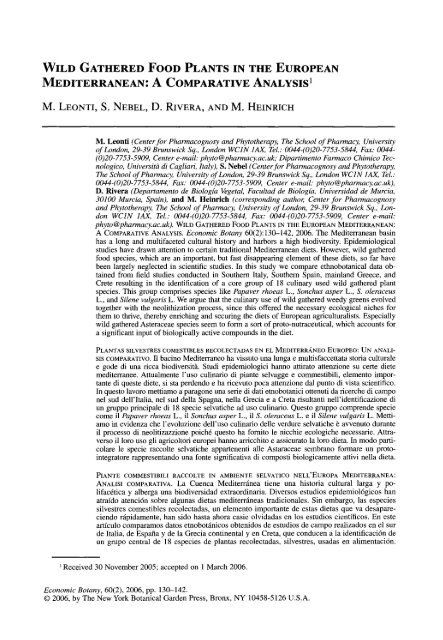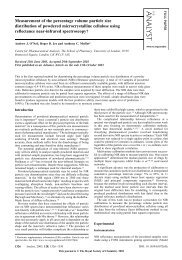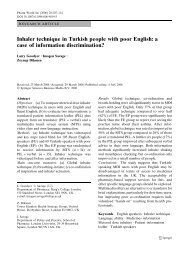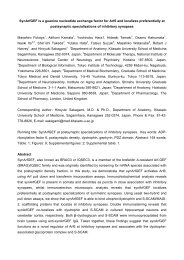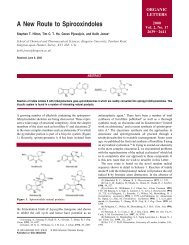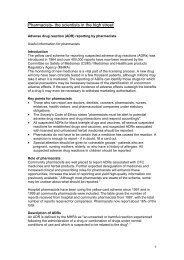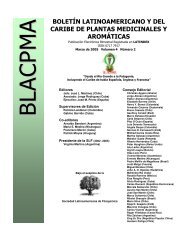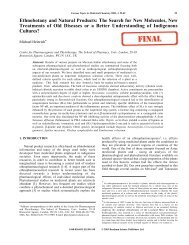pdf (springer nesli 2 licence) - Pharmacy Eprints
pdf (springer nesli 2 licence) - Pharmacy Eprints
pdf (springer nesli 2 licence) - Pharmacy Eprints
Create successful ePaper yourself
Turn your PDF publications into a flip-book with our unique Google optimized e-Paper software.
WILD GATHERED FOOD PLANTS IN THE EUROPEAN<br />
MEDITERRANEAN: A COMPARATIVE ANALYSIS 1<br />
M. LEONTI, S. NEBEL, D. RIVERA, AND M. HEINRICH<br />
M. Leonti (Center for Pharmacognosy and Phytotherapy, The School of <strong>Pharmacy</strong>, University<br />
of London, 29-39 Brunswick Sq., London WC1N lAX, Tel.: 0044-(0)20-7753-5844, Fax: 0044-<br />
(0)20-7753-5909, Center e-mail: phyto@pharmacy.ac.uk; Dipartimento Farmaco Chimico Tec-<br />
nologico, Universitg~ di Cagliari, Italy), S. Nebel (Center for Pharmacognosy and Phytotherapy,<br />
The School of <strong>Pharmacy</strong>, University of London, 29-39 Brunswick Sq., London WC1N lAX, Tel.:<br />
0044-(0)20-7753-5844, Fax: 0044-(0)20-7753-5909, Center e-mail: phyto@pharmacy.ac.uk),<br />
D. Rivera (Departamento de Biolog[a Vegetal, Facultad de Biologda, Universidad de Murcia,<br />
30100 Murcia, Spain), and M. Heinrich (corresponding author, Center for Pharmacognosy<br />
and Phytotherapy, The School of <strong>Pharmacy</strong>, University of London, 29-39 Brunswick Sq., Lon-<br />
don WC1N lAX, Tel.: 0044-(0)20-7753-5844, Fax: 0044-(0)20-7753-5909, Center e-mail:<br />
phyto@pharmacy.ac.uk). WILD GATHERED FOOD PLANTS 1N THE EUROPEAN MEDITERRANEAN:<br />
A COMPARATIVE ANALYSIS. Economic Botany 60(2): 130-142, 2006, The Mediterranean basin<br />
has a long and multifaceted cultural history and harbors a high biodiversity. Epidemiological<br />
studies have drawn attention to certain traditional Mediterranean diets. However, wild gathered<br />
food species, which are an important, but fast disappearing element of these diets, so far have<br />
been largely neglected in scientific studies. In this study we compare ethnobotanical data ob-<br />
tained from field studies conducted in Southern Italy, Southern Spain, mainland Greece, and<br />
Crete resulting in the identification of a core group of 18 culinary used wild gathered plant<br />
species. This group comprises species like Papaver rhoeas L., Sonchus asper L., S. oleraceus<br />
L., and Silene vulgaris L. We argue that the culinary use of wild gathered weedy greens evolved<br />
together with the neolithization process, since this offered the necessary ecological niches for<br />
them to thrive, thereby enriching and securing the diets of European agriculturalists. Especially<br />
wild gathered Asteraceae species seem to form a sort of proto-nutraceutical, which accounts for<br />
a significant input of biologically active compounds in the diet.<br />
PLANTAS SILVESTRES COMESTIBLES RECOLECTADAS EN EL MEDITERR~NEO EUROPEO: UN ANALI-<br />
SIS COMPARATIVO. I1 bacino Mediterraneo ha vissuto una lunga e multisfaccettata storia culturale<br />
e gode di una ricca biodiversitS. Studi epidemiologici hanno attirato attenzione su certe diete<br />
mediterranee. Attualmente l'uso culinario di piante selvagge e commestibili, elemento impor-<br />
tante di queste diete, si sta perdendo e ha ricevuto poca attenzione dal punto di vista scientifico.<br />
In questo lavoro mettiamo a paragone una serie di dati etnobotanici ottenuti da ricerche di campo<br />
nel sud dell'Italia, nel sud della Spagna, nella Grecia e a Creta risultanti nell'identificazione di<br />
un gruppo principale di 18 specie selvatiche ad uso culinario. Questo gruppo comprende specie<br />
come il Papaver rhoeas L., il Sonchus asper L., il S. oleraceus L. e il Silene vulgaris L. Metti-<br />
amo in evidenza che l'evoluzione dell'uso culinario delle verdure selvatiche ~ avvenuto durante<br />
il processo di neolitizazzione poichd questo ha fomito le nicchie ecologiche necessarie. Attra-<br />
verso il lorD uso gli agricoltori europei hanno arricchito e assicurato la lorD dicta. In modo parti-<br />
colare le specie raccolte selvatiche appartenenti alle Astaraceae sembrano formare un proto-<br />
integratore rappresentando una fonte significativa di composti biologicamente attivi nella dicta.<br />
PIANTE COMMESTIBILI RACCOLTE IN AMBIENTE SELVATICO NELL'EUROPA MEDITERRANEA:<br />
ANALISI COMPARATIVA. La Cuenca Mediterr~nea tiene una historia cultural larga y po-<br />
lifacrtica y alberga una biodiversidad extraordinaria. Diversos estudios epidemiolrgicos han<br />
atrafdo atencidn sobre algunas dietas mediterr~ineas tradicionales. Sin embargo, las especies<br />
silvestres comestibles recolectadas, un elemento importante de estas dietas que va desapare-<br />
ciendo r~pidamente, han sido hasta ahora casie olvidadas en los estudios cientfficos. En este<br />
artfculo comparamos datos etnobotfinicos obtenidos de estudios de campo realizados en el sur<br />
de Italia, de Espafia y de la Grecia continental yen Creta, que conducen a la identificacidn de<br />
un grupo central de 18 especies de plantas recolectadas, silvestres, usadas en alimentacidn.<br />
l Received 30 November 2005; accepted on 1 March 2006.<br />
Economic Botany, 60(2), 2006, pp. 130-142.<br />
9 2006, by The New York Botanical Garden Press, Bronx, NY 10458-5126 U.S.A.
2006] LEONTI, ET AL.: WILD EUROPEAN FOOD PLANTS 131<br />
Este grupo comprende especies como Papaver rhoeas L., Sonchus asper L., S. oleraceus L. y<br />
Silene vulgaris L. Sostenemos que el uso culinario de verduras silvestres y de hierbas de los<br />
campos de cultivo evolucion6 asociado al proceso del neolitizaci6n, que ofreci6 los nichos<br />
ecol6gicos necesarios para el desarrollo de estas especies, enriqueciendo y afianzando las di-<br />
etas de los primeros agricultores europeos. Especialmente las especies silvestres recolectadas<br />
de [la familia] Asteraceae, parecen constituir un tipo de proto-nutracrutico que aporta signi-<br />
ficativamente compuestos biol6gicamente activos a la dieta.<br />
Key words: Mediterranean basin, wild (local) food, comparative analysis, (comparative)<br />
ethnobotany, Neolithicum, weeds, Mediterranean diet(s), history of plant use.<br />
INTRODUCTION<br />
Both in anthropology and ecology, a now clas-<br />
sical distinction has been made between hunter-<br />
gatherers and agriculturalists. The former were<br />
seen to rely regularly on non-cultivated managed<br />
plants, and the latter strictly on cultivated ones<br />
(Shanin 1971). In recent years, various studies<br />
have shown that non-cultivated wild gathered<br />
plants play an important role in supplying sea-<br />
sonal food in rural Mediterranean communities<br />
(Pieroni et al. 2002; Bonet and Vall~s 2002;<br />
Rivera et al. 2005; Tard~o et al. 2005; Tardio et<br />
al. 2006). Wild gathered weedy greens, compris-<br />
ing vegetables and salads, are an especially<br />
important element in local dietary traditions.<br />
Non-cultivated plants grow spontaneously in<br />
self-maintaining populations in natural or semi-<br />
natural ecosystems and can exist independently<br />
of direct human action (Heywood 1999). In prac-<br />
tice, the distinction between cultivated and non-<br />
cultivated species or varieties is not easy since a<br />
continuous spectrum between totally wild and<br />
fully domesticated species exists (Harlan 1992;<br />
Moerman 1994; Logan and Dixon 1994; Hey-<br />
wood 1999). For instance, there are weedy and<br />
cultivated races of einkorn, barley, sorghum, rice,<br />
oats, pearl millet, potato, tomato, pepper, sun-<br />
flower, carrots, radish, and lettuce (Harlan 1992).<br />
Plant and animal domestication is regarded<br />
as the most important cultural development in<br />
the past 13,000 years of human history and, as a<br />
consequence, today we depend on that tiny<br />
fraction of several species that have been do-<br />
mesticated (Diamond 2002). But anthropolo-<br />
gists and nutritionists argue that contemporary<br />
humans are, in a genetic sense, still Stone Agers<br />
and, therefore, are adapted to a pre-agricultural<br />
nutritional pattern (Mann 2004). In contrast to<br />
our current Western diet, the Paleolithic diet<br />
generally consisted more of animal protein, less<br />
serum cholesterol-raising fat, an almost equal<br />
omega-6/omega-3 fatty acid ratio, almost exclu-<br />
sively fruit- and vegetable-derived carbohy-<br />
drates (no grains, refined sugars, or dairy prod-<br />
ucts), more fiber, and more phytochemicals.<br />
Eaton (2000) and Cordain et al. (2002) com-<br />
pared a Paleolithic model experimental diet,<br />
and dietary and epidemiological data of hunter-<br />
gatherers with dietary and epidemiological data<br />
of current Western civilization. In conclusion<br />
they claimed that the alteration of seven major<br />
functional dietary factors, i.e., glycemic load,<br />
fatty acid balance, macronutrient balance, trace<br />
nutrient density, acid-base balance, sodium-<br />
potassium balance, and fiber content, are in<br />
great part responsible for western life-style dis-<br />
eases like cardiovascular diseases, diabetes,<br />
neoplastic diseases, and osteoporosis (Eaton<br />
2000; Mann 2004; Cordain et al. 2005).<br />
With respect to the Mediterranean region,<br />
epidemiological studies confirm the influence<br />
of dietary habits on morbidity patterns and cor-<br />
relate the consumption of fruits, vegetables,<br />
olive oil, and red wine specifically with a lower<br />
rate of coronary heart disease, diabetes, cancer,<br />
and a greater longevity in general (De Lorgeril<br />
et al. 1994, 1998; Keys 1970; Keys 1980;<br />
Trichopoulou et al. 2000). More specifically, a<br />
clinical trial within the "Lyon Diet Heart<br />
Study" concluded that an alpha-linolenic acid-<br />
rich Mediterranean diet was able to lower the<br />
rate of cardiovascular complications after my-<br />
ocardial infarction (De Lorgeril et al. 1994,<br />
1999). Sources of omega-3 fatty acids like<br />
alpha linolenic acid are green vegetables, nuts,<br />
seeds, game, and wild seafood while wild gath-<br />
ered vegetables are especially rich in alpha-<br />
linolenic acids and antioxidants (Biesalski and<br />
Grimm 2004; Crawford et al. 2000; Lionis et al.<br />
1998; Zeghichi et al. 2003).<br />
Also, food is far more than nutrition or culi-<br />
nary art. The relationship between diet and the<br />
condition of the human body and psyche has
132 ECONOMIC BOTANY [VOL. 60<br />
been a subject of discussion at least since<br />
Plato's times (Skiadas and Lascaratos 2001). It<br />
is now generally accepted that plants may be<br />
used both as medicine and food; moreover, it is<br />
difficult to draw a separating line between these<br />
two categories (Etkin 1996; Moerman 1994;<br />
Rivera et al. 2005).<br />
The main goals of this project were to assess<br />
the diversity of wild gathered food plants and<br />
their role in local nutrition and cuisine from a<br />
socio-economic and socio-anthropological per-<br />
spective as well as to characterize a representa-<br />
tive part of the ethnobotanically documented<br />
plant species pharmacologically as well as<br />
chemically (Heinrich et al. 2005; Loboda et al.<br />
2005; Schaffer et al. 2005; The Local Food-<br />
Nutraceutical Consortium 2005). In this contri-<br />
bution, which follows a series of publications<br />
addressing the pharmacological properties of<br />
wild gathered food plants, we want to explore<br />
the historical context, characterize the differ-<br />
ences between wild gathered and cultivated<br />
species, and compare the ethnobotanical results<br />
of the three major field study sites within this<br />
project: Spain, Italy, and Greece.<br />
THE PREHISTORIC AND HISTORIC<br />
CONTEXT OF AGRICULTURAL<br />
CROPS~ VEGETABLES~ AND WEEDS<br />
Wild gathered food plants have been part of<br />
the human diet since time immemorial and it is<br />
argued that past societies made more use of the<br />
wild flora than is done nowadays (Diamond<br />
2002; Harlan 1992; King 1994). Today, only in<br />
rural communities and especially among (ex-<br />
tant) hunter-gatherer societies do wild gathered<br />
foods contribute substantially to the human<br />
diet. This is certainly true since, beginning<br />
about 8600-8000 BC, agricultural practices<br />
began to provide humankind with carbohy-<br />
drates from cereals and proteins from pulses<br />
(Zohary and Hopf 2000). The earliest remains<br />
of the neolithization process in Southern Eu-<br />
rope are dated to 6800 BC in Greece and<br />
around 6000 BC in Southeast Italy, Sicily,<br />
Southern France, and Southern Spain (Zohary<br />
and Hopf 2000).<br />
As a consequence of agricultural activities,<br />
the diet changed dramatically to the heavy re-<br />
liance on only two or three staple crops (Logan<br />
and Dixon 1994). Apparently there were no<br />
vegetables among the "first wave" of domesti-<br />
cates in the Near East (Zohary and Hopf 2000).<br />
The earliest remains of cultivated vegetables<br />
stem from Bronze-Age Egypt (around 2000<br />
BC), but since the soft and therefore easily per-<br />
ishable parts of tubers and vegetables stand a<br />
low chance of being charred and preserved in<br />
archaeological contexts, it is impossible to say<br />
when and where exactly vegetables were culti-<br />
vated for the first time (Zohary and Hopf<br />
2000). In large part, however, cultivated veg-<br />
etables represent an ecological by-product of<br />
early agricultural practices by entering domes-<br />
tication via the back door of weed evolution<br />
(Logan and Dixon 1994; Willerding 1986; Zo-<br />
hary and Hopf 2000). Here we treat weeds as<br />
"wild plants" because their gene pool is not af-<br />
fected deliberately or intentionally by human<br />
activity, even though they thrive in domesti-<br />
cated landscapes. Presumably tolerated and<br />
gathered weeds co-evolved with the crop har-<br />
vest techniques until being taken actively into<br />
cultivation and transformed into the agricul-<br />
tural races known today.<br />
During early agriculture, plant species from<br />
natural communities--which were pioneers of<br />
secondary successions and endowed with short<br />
life cycles and high reproductive capacity--in-<br />
vaded the open space that had been created for<br />
crop cultivation (Barrett 1983). By evolving into<br />
weedy forms and thriving on the tilled arable<br />
land, they created serious problems because<br />
practices that tend to favor crops also tend to<br />
favor weeds (Harlan 1992; Zohary and Hopf<br />
2000). Weed evolution went hand-in-hand with<br />
crop cultivation (Harlan 1992; Zohary and Hopf<br />
2000) because weeds belong to the same ecolog-<br />
ical type as most crop plants (Willerding 1986).<br />
Generally, weeds accompanying agricultural<br />
crops are short-lived plants with life cycles<br />
adapted to the specific crop plants and, in some<br />
cases, can be distributed only together with these<br />
"hosts" (Jacomet et al. 1989; Willerding 1986).<br />
The Middle East is not only one of the largest<br />
gene centers for cultivated plants in the world,<br />
but it is also the largest center for weeds and the<br />
cradle for many weeds common to the temperate<br />
and warm-temperate zones of the world (Zohary<br />
1973). Our modern weeds, and presumably all of<br />
our obligate weeds, did not exist in their present<br />
form before agriculture (Harlan 1992).<br />
Most if not all leafy wild vegetables and the<br />
wild progenitors of today's cultivated vegeta-<br />
bles are weeds (Maurizio 1927). For example,<br />
the family Brassicaceae furnishes many weeds,
2006] LEONTI, ET AL.: WILD EUROPEAN FOOD PLANTS 133<br />
wild gathered food species and crop plants. In<br />
Sicily alone, 24 wild Brassicaceae from 16 gen-<br />
era are occasionally exploited as vegetables<br />
(Heywood 1999), and at least 13 European<br />
Brassicaceae species are under cultivation<br />
(Franke 1997; Harlan 1992). The genera Bras-<br />
sica, Sinapis, and Raphanus are referred to es-<br />
pecially as aggressive weeds capable of infest-<br />
ing agricultural land. These genera also account<br />
for many cultivated and wild-gathered species<br />
and varieties (Heywood 1999; Maurizio 1927;<br />
Zohary and Hopf 2000).<br />
The habitats for weeds in Central Europe de-<br />
veloped with agriculture and the construction of<br />
villages around 5500 BC (4500 BC uncal.)<br />
(Willerding 1986). Weeds follow ecologic<br />
niches created by human activity like fields,<br />
gardens, fallow grounds, pastures, and villages<br />
as well as natural disturbances of all kinds.<br />
Also, they can be introduced intentionally or<br />
unintentionally into ecosystems (Fenton 2000;<br />
Harlan 1992; Stepp and Moerman 2001). Be-<br />
fore the adaptation of agriculture in Central Eu-<br />
rope, weeds would have had a chance to thrive<br />
only in very few highly frequented Mesolithic<br />
resting areas (Willerding 1986), anthropogenic<br />
clearances, and natural succession zones. Fur-<br />
thermore, unintentional introduction of weeds<br />
during the Mesolithic period could have oc-<br />
curred only with species that have bur fruits;<br />
later species with shedding seeds were intro-<br />
duced by way of contaminated crop seeds<br />
spreading via the corridor of the neolithization<br />
process from the Near East and the Balkans<br />
(Willerding 1986). Prior to agricultural prac-<br />
tice, habitats where wild leafy vegetables could<br />
thrive and be gathered were marginal and had<br />
very limited extensions in Europe since dense<br />
woody ecosystems dominated the landscape<br />
(Eberle 1975; Harlan 1992; Willerding 1986).<br />
Agricultural practice has not decreased the<br />
availability of wild plant resources as noted, for<br />
example, by King (1994) but rather has<br />
changed the bias from starchy resources from<br />
trees (acorns, nuts, beechnuts, cambium)<br />
toward a diversification and increase in the use<br />
of weeds as vegetables. Apart from providing<br />
valuable nutrients, vitamins, omega-3 fatty<br />
acids, phytochemicals, antioxidants, and fiber,<br />
these vegetables were also part of the back-up<br />
resources should the crop harvest fail (Fenton<br />
2000; Huss-Ashmore and Johnston 1994; Mau-<br />
rizio 1927).<br />
LOCAL FOOD IN ~OUTHERN EUROPE<br />
The many rural areas and communities in<br />
Southern Europe, which follow traditional life<br />
styles and which provide examples of tradi-<br />
tional agricultural practice, serve as prime ex-<br />
amples of using disturbed habitats and the<br />
weeds growing there. This includes the use of<br />
vegetables and fruits gathered in the wild.<br />
Southern Europe (Albania, Greece, Cyprus,<br />
Malta, Italy, France, Spain, Portugal) harbors a<br />
large number of botanical species, a great pro-<br />
portion of which are endemic (Eberle 1975). It<br />
is estimated that the Mediterranean countries<br />
altogether harbor around 20,000 botanical<br />
species (Bayer et al. 1990), including weedy<br />
and shrubby species, many of which have so far<br />
not been investigated chemically and pharma-<br />
cologically.<br />
However, due to changing socio-economical<br />
contexts, the use of wild gathered greens is de-<br />
creasing (Bonet and Vallbs 2002; Pieroni et al.<br />
2002; Tardfo et al. 2005). It is noteworthy that<br />
this loss in local knowledge and use of wild<br />
gathered plant species is paralleled by an in-<br />
creased interest in such resources by the gastro-<br />
nomic and intellectual elite in the search for<br />
new stimuli, culinary experiences, and healthy<br />
food (for example, visit http://www.slowfood.it).<br />
Forbes (1976) reports that in past winters,<br />
many villagers ate wild greens as a main dish<br />
with bread and olive oil as often as every day,<br />
compared to twice a week in 1975. In Galli-<br />
cian6 (Nebel 2005), people report that wild<br />
gathered foods were especially important dur-<br />
ing World War II when food was scarce and that<br />
some decades ago, people working in the fields<br />
ate freshly gathered wild vegetables with bread<br />
and olive oil for lunch. Wild gathered foods<br />
represented a healthy and adequate way to cope<br />
with food shortages derived from crop failure or<br />
financial poverty. Nowadays, young people<br />
from remote rural villages like Gallician6 mi-<br />
grate abroad where they work to earn money,<br />
which allows them to pay the bills and buy the<br />
Western goods they did not have before. The<br />
few young people remaining in the villages<br />
only occasionally follow the tradition of gather-<br />
ing wild foods since small food markets with<br />
conventional foods have opened and displaced<br />
the traditional life style.<br />
Nevertheless, wild vegetables and fruits are<br />
still used in traditional dishes mainly by the
134 ECONOMIC BOTANY [VOL. 60<br />
older generation. Both sexes gather wild veg-<br />
etables. In Castelmezzano (Southern Italy) and<br />
Sierra de Segura (Southern Spain), women are<br />
more knowledgeable, which seems to be the<br />
rule in the Mediterranean (Forbes 1976; Nebel<br />
2005; Pieroni et al. 2005; Verde et al. 1998,<br />
2001).<br />
Leafy wild greens can be gathered from late<br />
autumn until early summer with a peak of abun-<br />
dance in the springtime. Historically, winter is<br />
considered the worst time of the year because of<br />
the limited range of foods available. It is during<br />
this period that the wild gathered vegetables<br />
offer dietary diversity (Forbes 1976). Wild gath-<br />
ered vegetables therefore can be nutritionally<br />
important (Tukan et al. 1998) by supplying vita-<br />
mins, omega-3 fatty acids, polyunsaturated fatty<br />
acids (PUFAs), minerals, antioxidants, and fiber<br />
(Huss-Ashmore and Johnston 1994; Zeghichi et<br />
al. 2003) at a time when garden vegetables are<br />
not yet ready to be harvested and no fresh fruits<br />
are available.<br />
METHODS<br />
The field studies of the "Local Food-<br />
Nutraceuticals" project took place in six rural<br />
communities or regions of Greece, Italy, and<br />
Spain between 2002 and 2004; most of the indi-<br />
vidual studies already have been published. The<br />
fieldwork in Greece was undertaken in the Her-<br />
aklion province on the island of Crete and in<br />
the region of Zahorochoria in the province of<br />
Ioannina in the northwestern part of the Greek<br />
mainland. The Italian study sites are Castelmez-<br />
zano, a Southern Italian village in the region of<br />
Basilicata (Pieroni et al. 2005) and the ethnic<br />
Greek community of Gallician6 in the region of<br />
Calabria (Nebel 2005; Nebel et al. n.d.). The<br />
field sites in Spain were in the Serranfa de<br />
Cuenca, Sierras de Alcaraz and Segura, A1-<br />
bacete, and Murcia (Rivera et al. 2005; Verde et<br />
al. 2003).<br />
Similar methods, including semi-structured<br />
interviews and participant observation, were<br />
used in all the field sites to document the tradi-<br />
tional knowledge regarding wild gathered food<br />
plants. Detailed information about the species<br />
used including recipes, seasonal availability,<br />
and the popularity of their use was pooled in a<br />
database for in-depth analysis and comparison.<br />
In order to secure database uniformity and com-<br />
parability, mushrooms were excluded from the<br />
discussion even though they are eagerly gath-<br />
ered (for details, see Heinrich et al. 2005; Nebel<br />
et al. n.d.; Pieroni et al. 2005; Rivera et al.<br />
2005, 2006).<br />
RESULTS AND DISCUSSIONS<br />
FOOD PLANTS IN SIX MEDITERRANEAN<br />
REGIONS<br />
Wild gathered vegetables are a category of<br />
their own regarding folk taxonomic aspects. In<br />
Crete, edible wild greens are called vrouves or<br />
horta, while in Epirus they are called lahana. In<br />
Castellmezzano wild gathered greens are called<br />
foglie (leaves) and include semi-cultivated<br />
species (Pieroni et al. 2005), while in Galli-<br />
cian6 they are called chbrta (Nebel 2005), i.e.,<br />
greens used as food or herbs. The people inhab-<br />
iting the mountain ranges of Alcaraz and Se-<br />
gura of Southern Spain do not use a term to de-<br />
scribe wild gathered greens as a whole. Instead<br />
they use three terms to describe different<br />
groups of wild gathered greens: collejas de-<br />
scribes the plants from which the young sprouts<br />
and leaves are used; esparragos describes those<br />
from which the young shoots are eaten, such as<br />
Asparagus sp., Bryonia sp., or Humulus sp.;<br />
and the term chicorias refers to the Cichori-<br />
oides (Asteraceae), which typically is con-<br />
sumed raw in salads like Cichorium sp., Chon-<br />
drilla sp., Taraxacum sp., or Leontodon sp.<br />
(Verde et al. 2003).<br />
In the six field studies, we documented 318<br />
wild or semi-cultivated food plant species: 173<br />
species in Spain, 147 in Greece, and 84 in Italy<br />
(Fig. 1). Of these, only 18 are used in all three<br />
countries (Table 2). The genera with the highest<br />
number of species used are Taraxacum (11),<br />
Rumex (9), Allium (8), Prunus (8), and Onopor-<br />
don (7). The most common mode of prepara-<br />
tion is first cooking and then frying them to-<br />
gether with garlic and olive oil (Table 1). The<br />
plant family contributing the most members to<br />
wild gathered food plants is the Asteraceae with<br />
a total of 83 species (26%). The second most<br />
important family is the Rosaceae with 36 gath-<br />
ered species whose fruits are either eaten raw,<br />
dried, or in the form of jams. In general, wild<br />
fruit like blackberries, pears, or arbutus fruit,<br />
are preferably eaten by children (Forbes 1976;<br />
Gait and Gait 1978; Nebel 2005; Tardfo et al.<br />
2005). The 24 Liliaceae (s. 1.) are sought for<br />
their corms as well as for their shoots. Shoots<br />
such as Asparagus spp. are fried with eggs and
2006] LEONTI, ET AL.: WILD EUROPEAN FOOD PLANTS 135<br />
~Greece 147<br />
105<br />
26<br />
118<br />
27 -<br />
Spain 173)<br />
Fig. 1. Wild gathered species recorded during field research: Spain 173, Greece, 147, Italy 84.<br />
the bulbs of Muscari comosum (L.) Mill.,<br />
which have been in demand since the early<br />
Roman times (Apicius 1991), often pickled.<br />
The 20 Apiaceae are used as vegetables or<br />
salads [Apium nodiflorum (L.) Lag.] or as<br />
spices [Foeniculum vulgare ssp. piperitum<br />
(Ucria) Cout]. The Brassicaceae (19) are one of<br />
the most important sources for wild gathered<br />
greens as well as cultivated species. Eruca<br />
sativa Mill. (rocket salad) has become very<br />
popular in recent years and is used raw in sal-<br />
ads while species from the genus Brassica and<br />
Sinapis are boiled and then fried with garlic.<br />
Most of the 14 Lamiaceae are used as spices<br />
and infusions (Thymus spp., Mentha spp., and<br />
Origanum spp.) except Prasium majus L. from<br />
Crete, which is stir-fried or used in traditional<br />
vegetable pies. The Boraginaceae are frequently<br />
used in Spain (7 out of 11) where they are an<br />
ingredient for a hot-pot with chickpeas or pota-<br />
toes. The 10 Fabaceae are exploited for their<br />
seeds with a few exceptions where the flowers<br />
(Robinia pseudoacacia L.) or the roots (Gly-<br />
cyrrhiza glabra L.) are used.<br />
In order to contrast the importance of a plant<br />
family regarding their number of wild gathered<br />
species, the second column of Table 1 shows<br />
the number of cultivated species with European<br />
parentage. The plant family with most species<br />
under cultivation in Europe and adjacent areas<br />
is the Apiaceae with 14 species cultivated<br />
today while only one Boraginaceae (Borago of-<br />
ficinalis L.) is cultivated for food purposes<br />
(Franke 1997; Harlan 1992; Zohary and Hopf<br />
2000).<br />
A COMPARISON OF THE FOOD<br />
PLANT USAGE<br />
The most striking aspect of the comparison is<br />
the great diversity and relatively low degree of<br />
overlap of species used in the three countries,<br />
which of course depends also on the geographi-<br />
cal distribution of the species. On the other<br />
hand and considering the common cultural<br />
background, a comparison between the plants<br />
used by the descendents of the Magna Graecia<br />
in Southern Italy (Gallicianb) and in Greece<br />
(Crete and Epirus), both living in regions with<br />
similar vegetation, is highly illuminating (Hein-<br />
rich et al. 2005; Nebel and Heinrich n. d.). Of<br />
the 38 plants used in Gallicianb, 21 are used in<br />
Greece, too.<br />
Apium nodiflorum (L.) Lag is used in Italian<br />
communities and the Graecanic area, but only<br />
one reference to the use of A. nodiflorum in<br />
Greece (Cyprus) was found in the literature<br />
(Savvides 2000). Reseda alba L. is heavily used<br />
in Gallician6 but not in Italian communities
136<br />
TABLE 1.<br />
RANEAN.<br />
ECONOMIC BOTANY [VOL. 60<br />
PLANT FAMILIES MOST UTILIZED FOR WILD GATHERED FOODS IN THE EUROPEAN MEDITER-<br />
Number of<br />
Family species* Parts used Preparation Period of gathering<br />
Asteraceae 83 Whorls, shoots, stems, Boiled and fried with Spring<br />
(c:6/r:8) roots, receptacles olive oil and garlic<br />
Rosaceae 36 Fruits Raw, jam, dried Summer, autumn<br />
(c:l 3/r:3)<br />
Liliaceae (s. 1.) 24 Bulbs, corms Omelet, boiled and Spring, Autumn,<br />
(c:8/r:7) fried, pickled winter<br />
Apiaceae 20 Shoots, leaves, roots, Salad, boiled and fried, Spring, summer<br />
(c: 14/r: 1) seeds spice<br />
Brassicaceae 19 Shoots, leaves Salad, boiled and fried Winter, spring<br />
(c: 13/r:2)<br />
Lamiaceae 14 Aerial parts Spice, infusion Spring, summer<br />
(c:l l/r:5)<br />
Boraginaceae 11 Shoots Soups, stews, pies, Spring, summer<br />
(c: 1/r: 14) fried<br />
Fabaceae (s. 1.) 10 Fruits, aerial parts, Raw, boiled Spring, summer<br />
(c: 12/r:4) root, flower<br />
Polygonaceae 9 Leaves, shoots Boiled and fried, pies Spring<br />
(c:0)<br />
Chenopodiaceae 5 Shoots, aerial parts Boiled and fried, pies Spring, summer<br />
(c:4/r:9)<br />
Scrophulariaceae 5 Shoots Salad, boiled and fried Spring, summer<br />
(c:0)<br />
* Most important plant families as sources for wild gathered greens and fruits. Number of cultivated food species (c:)<br />
per family with European parentage are given in parenthesis as well as the ranking (r:) based on the number of cultivated<br />
species. For comparison: Poaceae 3 (c:l l/r:6). (after Harlan 1992, Franke 1997, Zohary and Hopf 2000).<br />
where the plant is considered too bitter. The<br />
tops of the shoots are eaten raw seasoned with<br />
olive oil or after being cooked and then stir-<br />
fried with garlic and olive oil. In the literature,<br />
only two references to the use of R. alba as<br />
food were found. First, young leaves of R. alba<br />
were used as vegetable in Greece (Heldreich<br />
1862) and, second, as salad by Greek farmers<br />
of the surroundings of Larnaca in Cyprus<br />
(Arnold Apostolides 1985). Interestingly, both<br />
records are from regions of the Eastern<br />
Mediterranean, which were, in historic times,<br />
part of the Greek and Byzantine empires, as the<br />
Graecanic area in Southern Italy. For some<br />
plants from Greece (GR) and Gallicianb (I),<br />
cognates were detected, which suggests that<br />
they have been used as vegetables since pre-<br />
Roman times: "tsochos" (GR) and "zuccho" (I)<br />
for Sonchus asper L. & S. oleraceus L., or "an-<br />
drakla" (GR) and "andrficla" (I) for Portulaca<br />
oleracea L. (see Table 2 and Nebel and Hein-<br />
rich n.d.).<br />
ARE WILD GATHERED AND CULTIVATED<br />
SPECIES THE SAME?<br />
In the field sites of this study, wild gathered<br />
greens are conceptualized as a distinct group of<br />
vegetables forming a category of their own re-<br />
garding local taxonomic classifications (Hein-<br />
rich et al. 2005). For culinary purposes, how-<br />
ever, the most common recipes use gathered<br />
species in an identical way to the cultivated<br />
ones. Often these two groups are combined in<br />
the same dish. The 11 most important plant<br />
families within the number of wild gathered<br />
food species comprise eight of the nine most<br />
important plant families regarding the number<br />
of species with a history of domestication in<br />
Europe (Table 1).<br />
However, wild gathered greens differ from<br />
cultivated vegetables regarding their chemical<br />
composition and nutritional value (Zeghichi et<br />
al. 2003). Apart from the selection for higher<br />
yields and ecological adaptation, cultivated
2006] LEONTI, ET AL.: WILD EUROPEAN FOOD PLANTS 137<br />
TABLE 2. WILD GATHERED AND SEMI-CULTIVATED PLANT SPECIES DOCUMENTED IN ALL THREE COUN-<br />
TRIES DURING THE CONSORTIUM'S FIELD WORK.<br />
Family<br />
Vernacular names<br />
Greek Italy Spain<br />
C~Crete G~Gallicianb A--Albacete<br />
Species E--Epiros CA--Castehnezzano CU--Cuenca<br />
Apiaceae Foeniculum vulgare ssp. Agriom~athos c M~saro ~<br />
piperitum (Ucria) fenucchiE salvaccE cA<br />
Cout.<br />
Asteraceae Chondrilla juncea L. ** Grospart6 G<br />
Boraginaceae<br />
Cichorium intybus L. RadNi c, G: **, cicoirE cA<br />
Rodikio c<br />
Crepis vesicaria L. Pikrosirfda c MarogliU A<br />
Hypochoeris radicata L. Pl~itsa c Costardeddhe G<br />
Lactuca serriola L. Agrio m~xulo c Glossa to sciddhio ~,<br />
seulo a gline e lactucastrE cA<br />
Scolymus hispanicus L. Asc61impros c Sculfmbri ~<br />
Sonchus asper L. Tsochos Zuccho a<br />
Sonchus oleraceus L. Tsochos Zuccho a, sivonE cA<br />
Borago officinalis L.<br />
Caryophyllaceae Silene vulgaris<br />
(Moench) Garke<br />
Chenopodiaceae Beta vulgaris ssp.<br />
maritima (L.) Arcang.<br />
Ericaceae Arbutus unedo L.<br />
Liliaceae Allium ampeloprasum L.<br />
Moraceae Ficus carica L.<br />
Papaveraceae Papaver rhoeas L.<br />
Portulacaceae<br />
Rosaceae<br />
Portulaca oleracea L.<br />
Crataegus monogyna<br />
Jacq.<br />
** plant used, but no vernacular name documented<br />
Burfinza Gabbufna G,<br />
vurrascinE ca,<br />
sucamelE cA<br />
Papflia Cavur~ci 6<br />
** JetE eA<br />
Kumari~i<br />
Prasfiki c<br />
Agriosuki~i<br />
Kutsumida c,<br />
Kontotsipa E<br />
Paparouna<br />
Glustrfda c,<br />
Andrakla E<br />
Trikokki~i<br />
species and races are selected for having a more<br />
palatable and "sweeter" taste, and they contain<br />
less fiber and secondary compounds (Johns<br />
1990). Wild gathered greens and fruits are more<br />
fibrous and contain higher concentrations and a<br />
greater diversity of secondary compounds.<br />
These secondary compounds are chemicals<br />
GrumE cA<br />
AgliE ardiddE cA<br />
Sico ~, fiche cA<br />
Paparfna ~, paparinE cA,<br />
scattEbottE cA<br />
Andr~icla G,<br />
PerchiazzE cA<br />
CeraseddE cA<br />
Hinojo<br />
Lizones A, talleras A,<br />
achicorias TM,<br />
chicorias TM<br />
Chicorias,<br />
achicorias<br />
Camarrojas<br />
Collejicas del prao A,<br />
hociquillos TM,<br />
morrillos TM,<br />
morrilla TM<br />
Cardenchilla<br />
Cardillos, cardillo<br />
Cerrajilla, crujiera<br />
Cerrajas A, forrajas A,<br />
borrajas A<br />
Cerrajilla TM,<br />
crujiera TM<br />
Borrajas<br />
Collejas<br />
Acelgas de campo<br />
Madrofios<br />
Ajoporros, ajos<br />
porros<br />
Higuera<br />
Babaoles dulces<br />
Verdolaga A,<br />
Verdulaga TM,<br />
emporretos TM<br />
Majoletas A,<br />
Majuelas TM<br />
with a wide range of potentially physiological<br />
and pharmacological interactions including<br />
toxic, antimicrobial, anti-inflammatory, anti-<br />
oxidant, anti-atherosclerotic, astringent, hypo-<br />
glycemic, appetizing, diuretic, stomachic,<br />
carminative, laxative, aphrodisiac, and more<br />
properties. Rivera et al. (2005) report on 145
138 ECONOMIC BOTANY [VOL. 60<br />
wild gathered food species from Alcaraz, Se-<br />
gura, and Serrania de Cuenca in Southern<br />
Spain. Of these 145 species, 81 are also used<br />
medicinally and 61 of those are administered<br />
orally using the same plant part used in the culi-<br />
nary preparations. Hence, the proportion of me-<br />
dicinal plants among gathered food species was<br />
found to be approximately twice as high as<br />
compared to cultivated food species. The phar-<br />
macological properties of food plants are<br />
widely recognized in many cultures and phar-<br />
macologically active phytochemicals may de-<br />
liberately be included in the diet (Johns 1990).<br />
These medicinal food species fit into the mod-<br />
em concept of a nutraceutical or functional<br />
food (see also the EU-project "Local Food-<br />
Nutraceuticals"; Heinrich et al. 2005; The<br />
Local Food-Nutraceutical Consortium 2005).<br />
The medicinal character of wild weedy greens<br />
has been described before (Etkin and Ross<br />
1983; Forbes 1976; Guarrera 2003; Pieroni et<br />
al. 2002). Forbes (1976) writes that people<br />
often claim that eating horta aids digestion and<br />
cleanses the blood as well as the rest of the<br />
body. In Crete, artichoke leaves and stalks are<br />
not only esteemed for their delicious taste but<br />
are also said to lower blood sugar levels and<br />
considered as a therapy to control diabetes type<br />
II. The corms of the tassel hyacinth (Muscari<br />
comosum (L.) Mill., syn. Leopoldia comosa<br />
(L.) Parl.) are used as an aphrodisiac. Amaran-<br />
thus spp. are used as a sedative and are said to<br />
alleviate inflamed joints. The inhabitants of the<br />
Graecanic area often ascribe a specific taste to<br />
singular plant species, particularly to ta chbrta<br />
species. Bitterness is associated with health and<br />
in Gallician6 the bitter tasting Lactuca viminea<br />
(L.) J. Presl. & C. Presl. or Reseda alba L. are<br />
considered to be healthy by being "good for the<br />
liver" and having blood-cleansing properties<br />
(Nebel et al. n.d.). Furthermore, Heldreich<br />
(1862) reports that the Greeks considered many<br />
Asteraceae species to be healthy because of<br />
their bitterness.<br />
It can be argued that the safety of these wild<br />
gathered greens has been evaluated empirically<br />
over the millennia by cultures and people.<br />
Nonetheless this ethnobotanical survey revealed<br />
some toxic species. We found that in Crete as<br />
well as in Catalonia (Bonet and Vall~s 2002),<br />
bracken fern Pteridium aquilinum (L.) Kuhn is<br />
used as a vegetable. This plant contains the car-<br />
cinogenic glycoside ptaquiloside (Frohne and<br />
Jensen 1998) and should be relished with pru-<br />
dence. The very palatable corms from Meren-<br />
dera montana Lange are occasionally used as a<br />
snack in Spain and were in demand as a famine<br />
food during the Spanish Civil War. The genus<br />
as well as the species is known to contain<br />
highly cytotoxic colchicine alkaloids (G6mez et<br />
al. 2003; Husek et al. 1989). The Boraginaceae<br />
Symphytum bulbosum Schimp. and Lithosper-<br />
mum arvense L. as well as the members of the<br />
genus Echium that are used as vegetables are<br />
likely to contain the hepatotoxic pyrrolizidine<br />
alkaloids (Frohne and Jensen 1998) and should<br />
be consumed in minor quantities. Except for M.<br />
montana, the chronic nature of these toxic ef-<br />
fects seems to be responsible for the local per-<br />
ception that the species is safe.<br />
When looking at the comparative importance<br />
of wild gathered versus cultivated food plants,<br />
another interesting pattern emerges. The impor-<br />
tance of plant families as a source for wild<br />
gathered food parallels their importance in agri-<br />
culture with the exception of the Poaceae and<br />
the Asteraceae (Table 1). According to Holm<br />
(1978), the Poaceae and the Asteraceae are the<br />
main source of noxious weeds and together ac-<br />
count for 38% of the world's worst weeds.<br />
Stepp and Moerman (2001) and Stepp (2004)<br />
have gathered evidence that suggests that weeds<br />
contain more bioactive secondary compounds<br />
when compared to a random selection of flora.<br />
While they include the world's most important<br />
crops, the Poaceae are one of the most under-<br />
represented plant families in terms of the num-<br />
ber of species they contribute to traditional<br />
pharmacopoeias (Leonti et al. 2003; Moerman<br />
1994; Stepp and Moerman 2001). Various rea-<br />
sons for this low appreciation with respect to<br />
medicinal uses like conspicuousness, grow-<br />
back strategy and low phytochemical diversity<br />
and content have been discussed (Stepp and<br />
Moerman 2001). The families that have very<br />
few taxa selected for cultivation are the Boragi-<br />
naceae, Polygonaceae, Scrophulariaceae, and,<br />
most importantly, with respect to their huge<br />
contribution to wild gathered greens, the Aster-<br />
aceae. The chemically very diversified Aster-<br />
aceae are the main source of medicinal plant<br />
species used by traditional societies in a variety<br />
of applications in the northern hemisphere<br />
(Leonti et al. 2003; Moerman et al. 1999; Stepp<br />
and Moerman 2001).<br />
Johns (1990) hypothesizes that once such sec-
2006] LEONTI, ET AL.: WILD EUROPEAN FOOD PLANTS 139<br />
ondary compounds may have served a prophy-<br />
lactic role in controlling the increased loads of<br />
parasites, infectious diseases, and ailments the<br />
Neolithic life style brought along. Furthermore,<br />
he argues that through time, plant secondary<br />
compounds became part of the normal digestive<br />
ecology of healthy individuals and populations<br />
and essential health promoting constituents in a<br />
balanced nutrition (Johns 1990). Wild gathered<br />
weedy greens and fruits may, therefore, not only<br />
be an emergency source of food in times of<br />
famine (as a source for additional carbohy-<br />
drates, proteins, vitamins, PUFAs, and miner-<br />
als), but they also compensate for the lack of<br />
pharmacologically active substances, which cul-<br />
tivated species lost during domestication. Weeds<br />
used as food might represent not only the miss-<br />
ing link between a presumably well-balanced<br />
Paleolithic diet (Cordain et al. 2005) and the rel-<br />
atively abruptly changing dietary pattems during<br />
the early Neolithic phase, but also the link be-<br />
tween the agriculturalists' diet and the one of the<br />
industrialized, post modem world.<br />
It is now well established that medicine may<br />
be food and food may be medicine (Etkin<br />
1996; Moerman 1994; Rivera et al. 2005).<br />
People who traditionally gather wild greens<br />
know about additional health beneficial proper-<br />
ties of wild gathered greens. Therefore, they<br />
can deliberately choose between cultivated and<br />
non-cultivated species available to them and<br />
seek desired pharmacological effects consum-<br />
ing traditional dishes including wild gathered<br />
greens.<br />
CONCLUSIONS<br />
With the onset of the Neolithic era, a new di-<br />
mension of human-plant relationship devel-<br />
oped. Ecological niches created by agricultural<br />
activity allowed genetically predisposed species<br />
to thrive and develop as weeds in close human<br />
vicinity. During the expansion of the Neolithic<br />
economy, the seeds of weeds were transported<br />
and distributed together with the crop seeds and<br />
thereby invaded new territory where the weedy<br />
community could affiliate and incorporate new<br />
species.<br />
Based on the present discussion, we suggest<br />
that the transition from the late Paleolithic and<br />
Mesolithic toward the Neolithic economy was<br />
accompanied by a diversification and increase<br />
in the use of weeds as vegetables in the Near<br />
East, the Mediterranean basin, and temperate<br />
Europe, remnants of which can still be found in<br />
some local and traditional knowledge systems.<br />
While, as a result of cereal cultivation, the ex-<br />
ploitation of starchy resources from trees de-<br />
clined and continued to play a role only as<br />
emergency foods, the increasing culinary use of<br />
wild gathered weedy greens also reflects agri-<br />
culturalists' dietary needs regarding micro-<br />
nutrients and plant secondary compounds. Es-<br />
pecially the wild gathered Asteraceaen food<br />
species seem to form a type of proto-<br />
nutraceuticals, which together with the other<br />
wild gathered species account for a significant<br />
input of biologically active secondary com-<br />
pounds in the diet. A traditional lunch observed<br />
by Nebel et al. (n.d.) in which, for example,<br />
pasta (Triticum durum Desf., Poaceae) was<br />
served as a first course and wild gathered<br />
greens (mixed Asterceae and other plant fami-<br />
lies) as a second course, or the combination of<br />
bread with ta chbrta exemplifies the dualism of<br />
food as medicine. Plants from the Poaceae fam-<br />
ily (energy) are consumed together with Aster-<br />
aceae (nutrients and medicine).<br />
Further, we suggest that, as a consequence,<br />
this intimate human-plant relationship, which is<br />
represented by the increasing use of weeds as a<br />
food source, promoted the development of the<br />
Neolithic pharmacopoeias. Changing cultural<br />
and environmental factors during the Neolithic<br />
economy--i.e., changes in the staple diet, the<br />
increase in the prevalence and variety of dis-<br />
eases, the higher fertility rate, and the more<br />
sedentary life-style--required new pharmaco-<br />
logical regimes (Brown 1985; Logan and Dixon<br />
1994). The incorporation of weedy and spicy<br />
species, rich in bioactive secondary com-<br />
pounds, now thriving fight in front of the<br />
doorsteps, led to an expansion of the pharma-<br />
copoeias. This scenario is in accordance with<br />
Brown's observation (1985) that agricultural<br />
people generally recognize and rely on a greater<br />
variety of wild plants than do hunter-gatherers.<br />
Today, we rely on a narrow range of foods<br />
(Diamond 2002; Moerman 1994), which addi-<br />
tionally was selected for a narrower and lower<br />
spectrum of phytochemicals. Useful biochemi-<br />
cals like vitamins, flavonoids, omega-3 fatty<br />
acids, PUFAs, and minerals may fall short in<br />
our Westemized urban culinary scheme. There-<br />
fore, commercialized vitamins and nutraceuti-<br />
cals have been advertised to provide modern<br />
humans with sufficient beneficial cofactors.
140 ECONOMIC BOTANY [VOL. 60<br />
The culinary use of the vast array of wild<br />
gathered vegetables and fruits observed in this<br />
and previous studies is part of the (Mediter-<br />
ranean) agriculturalists' traditional knowledge<br />
about a balanced healthy diet and has become a<br />
more and more neglected resource. Through<br />
comparative analysis, we have identified a num-<br />
ber of species that belong to a core group of<br />
wild gathered vegetables with an inter-cultural<br />
acceptance. Such species might contribute to a<br />
more diverse assortment of vegetables in city<br />
markets, attract consumers' attention, and<br />
thereby could help to cure non-adaptive food<br />
habits at its very root.<br />
ACKNOWLEDGMENTS<br />
The input of all members of the consortium<br />
"Local Food-Nutraceuticals" is gratefully ac-<br />
knowledged. We specifically would like to<br />
thank Zacharias Kyproitakis (Heraklion) for<br />
contributing some specific ethnobotanical data<br />
from Greece and Andrea Pieroni (Bradford) for<br />
contributions at an early stage of this project. A<br />
contract with the European Commission under<br />
KA1 'Food, Nutrition and Health' (FP5) made<br />
this research possible (QLRT-2001-00173;<br />
2002-2004).<br />
LITERATURE CITED<br />
Apicius, M.G. 1991. Das ROmische Kochbuch des<br />
Apicius. Apicii Libri Decem Qui Dicuntur De Re<br />
Coquinaria Et Excerpta A Vinidario. E Reclam<br />
jun. GmbH & Co., Stuttgart, Germany.<br />
Arnold Apostolides, N. 1985. Contribution a la con-<br />
naissance ethnobotanique et medicinale de la flore<br />
de Chipre. Universit6 de Paris. Paris (PhD The-<br />
sis).<br />
Barrett, S. C.H. 1983. Crop Mimicry in Weeds. Eco-<br />
nomic Botany 37:255-282.<br />
Bayer, E., K. E Buttler, X. Finkenzeller, and J. Grau.<br />
1990. Plantas del Mediterr~ineo. Naturart, S. A. Es<br />
un libro BLUME, Barcelona.<br />
Biesalski, H.K. and E Grimm. 2004. Taschenatlas<br />
der Em~ihmng (3. Aufl.). Georg Thieme Verlag,<br />
Stuttgart, New York. [English translation: 2005,<br />
Pocket Atlas of Nutrition].<br />
Bonet, M.A. and J. Vall's. 2002. Use of non-crop<br />
food vascular plants in Montseny biosphere re-<br />
serve (Catalonia, Iberian Peninsula). International<br />
Journal of Food Science and Nutrition 53:225-<br />
248.<br />
Brown, C.H. 1985. Mode of subsistence and folk bi-<br />
ological taxonomy. Current Anthropology 26:43-<br />
64.<br />
Cordain, L., S.B. Eaton, J. Brand-Miller, N. Mann,<br />
and K. Hill. 2002. The paradoxical nature of<br />
hunter-gatherer diets: Meat-based, yet not athero-<br />
genic. European Journal of Clinical Nutrition 56<br />
(S):42-52.<br />
Cordain, L., S.B. Eaton, A. Sebastian, N. Mann, S.<br />
Lindeberg, B.A. Watkins, J.H. O'Keefe, and J.<br />
Brand-Miller. 2005. Origins and evolution of the<br />
western diet: Health implications for the 21st cen-<br />
tury. American Journal of Clinical Nutrition<br />
81:341-354.<br />
Crawford, M., C. Galli, E Visioli, S. Renaud, A. E<br />
Simopoulos, and A.A. Spector. 2000. Role of<br />
plant-derived omega--3 fatty acids in human nu-<br />
trition. Annals of Nutrition and Metabolism<br />
44:263-265.<br />
De Lorgeril M., S. Renaud, N. Mamelle, E Salen, J. L.<br />
Martin, I. Monjaud, J. Guidollet, E Touboul, and J.<br />
Delaye. 1994. Mediterranean alpha-linolenic acid-<br />
rich diet in secondary prevention of coronary heart<br />
disease. Lancet 11:343(8911): 1454-1459.<br />
De Lorgeril M., E Salen, J. L. Martin, I. Monjaud, P.<br />
Boucher, and N. Mamelle. 1998. Mediterranean<br />
dietary pattern in a randomized trial. Prolonged<br />
survival and possible reduced cancer rate.<br />
Archives of Internal Medicine 158:1181 - 1187.<br />
De Lorgeril M., E Salen, J.L. Martin, I. Monjaud, J.<br />
Delaye, and N. Mamelle. 1999. Mediterranean<br />
diet, traditional risk factors and the rate of cardio-<br />
vascular complications after myocardial infarc-<br />
tion. Final report of the Lyon Diet Heart Study.<br />
Circulation 99:779-785.<br />
Diamond, J. 2002. Evolution, consequences and fu-<br />
ture of plant and animal domestication. Nature<br />
418:700-707.<br />
Eaton, S.B. 2000. Paleolithic vs. modem diets--Se-<br />
lected pathophysiological implications. European<br />
Journal of Nutrition 39:67-70.<br />
Eberle, G. 1975. Pflanzen am Mittelmeer. Mediten-ane<br />
Pflanzengemeinschaften Italiens und Griechen-<br />
lands rnit Ausblick auf das ganze Mittelmeergebiet.<br />
Verlag von Waldemar Kramer, Frankfurt am Main.<br />
Etkin, N. and P. Ross. 1983. Malaria, medicine and<br />
meals: Plant use among the Hausa and its impact<br />
on disease. Pages 231-259 in L. Romanucci-<br />
Ross, D. Moerman, and L. Tancredi, eds., The an-<br />
thropology of medicine: From culture to method.<br />
Bergin and Garvey, New York.<br />
Etkin, N. 1996. Medicinal cuisines: Diet and ethno-<br />
pharmacology. International Journal of Pharmacog-<br />
nosy 34:313-326.<br />
Fenton, A. 2000. Wild plants and hungry times.<br />
Pages 182-194 in E Lysaght, ed., Food from na-<br />
ture, attitudes, strategies and culinary practices,<br />
Proceedings of the 12th Conference of the Inter-<br />
national Commission for Ethnological Food Re-<br />
search, Umea and Frostviken, Sweden, 8-14 June,<br />
1998. Acta Academiae Regiae Gustavi Adolphi<br />
LXXI, Uppsala.
2006] LEONTI, ET AL.: WILD EUROPEAN FOOD PLANTS 141<br />
Forbes, M. H.C. 1976. Gathering in the Argolid: A<br />
subsistence subsystem in a Greek agricultural<br />
community. Annals of the New York Academy of<br />
Science 268:251-264.<br />
Franke, W. 1997. Nutzpflanzenkunde. Nutzbare<br />
Gew~ichse der gem~issigten Breiten, Subtropen<br />
und Tropen. Georg Thieme Verlag, New York.<br />
Frohne, D. and U. Jensen. 1998. Systematik des<br />
Pflanzenreichs. Unter Besonderer Berticksichti-<br />
gung Chemischer Merkmale und Pfianzlicher<br />
Drogen. Wissenschaftliche Verlagsgesellschaft<br />
mbH Stuttgart.<br />
Galt, A.H. and J.W. Galt. 1978. Peasant use of some<br />
wild plant on the island of Pantelleria, Sicily. Eco-<br />
nomic Botany 32:20-26.<br />
G6mez, D., J. Azorin, J. Bastida, E Viladomat, and<br />
C. Codina. 2003. Seasonal and spatial variations<br />
of alkaloids in Merendera montana in relation to<br />
chemical defense and phenology. Journal of<br />
Chemical Ecology 29:1117-1126.<br />
Guarrera, P. M. 2003. Food medicine and minor nour-<br />
ishment in the folk traditions of Central Italy<br />
(Marche, Abruzzo and Latium). Fitoterapia<br />
74:515-544.<br />
Harlan, J.R. 1992. Crops & Man. 2nd ed. American<br />
Society of Agronomy, Inc. Crop Science Society<br />
of America, Inc. Madison, Wisconsin.<br />
Heinrich, M., M. Leonti, S. Nebel, and W. Peschel.<br />
2005. "Local food nutraceuticals": An example of<br />
a multidisciplinary research project on local<br />
knowledge. Journal of Physiology and Pharma-<br />
cology 56 (S):5-22.<br />
Heldreich, T. 1862. Die Nutzpflanzen Griechenlands:<br />
Mit besonderer Beriicksichtigung der neugriechis-<br />
chen und pelasgischen Vulgarnamen. Karl<br />
Wilberg, Athens, Greece.<br />
Heywood, V. 1999. Use and potential of wild plants<br />
in farm households. FAO Farm Systems Manage-<br />
ment Series 15.<br />
Holm, L. 1978. Some characteristics of weed prob-<br />
lems in two worlds. Proceedings of the Western<br />
Society of Weed Sciences 31:3-12. Pages 42-43<br />
in R.L. Zimdahl, ed., 1999. Fundamentals of<br />
Weed Sciences. 2nd ed. Academic Press, New<br />
York.<br />
Husek, A., N. Stittilpinar, H. Potesilov~i, S. Dvorack-<br />
ov~i, V. Hanus, P. Sedemera, P. Malon, and V.<br />
Simanek. 1989. Alkaloids and phenolics of three<br />
Merendera species. Phytochemistry 28:3217-<br />
3219.<br />
Huss-Ashmore, R. and S.L. Johnston. 1994. Wild<br />
plants as cultural adaptations to food stress. Pages<br />
62-82 in Nina L. Etkin, ed., Eating on the wild<br />
side. University of Arizona Press, Tucson, Ari-<br />
zona.<br />
Jacomet, S., C. Brombacher, and M. Dick. 1989.<br />
Archaobotanik am Ztirichsee. Ackerbau Sammel-<br />
wirtschafl und Umwelt von Neolithischen und<br />
Bronzezeitlichen Seeufersiedlungen im Raum<br />
Ztirich. Orell Ftissli Verlag, Ztirich.<br />
Johns, T. 1990. With bitter herbs they shall eat it:<br />
Chemical ecology and the origins of human diet<br />
and medicine. The University of Arizona Press,<br />
Tucson, Arizona.<br />
Keys, A. 1970. Coronary heart disease in 7 countries.<br />
Circulation 41 (S): 1-211.<br />
Keys, A. 1980. Seven countries: A multivariate analy-<br />
sis of death and coronary heart disease. Harvard<br />
University Press, Cambridge, Massachusetts.<br />
King, F.B. 1994. Interpreting wild plant foods in ar-<br />
chaeological record. Pages 185-209 in Nina L.<br />
Etkin, ed., Eating on the wild side. University of<br />
Arizona Press, Tucson.<br />
Leonti, M., E Ramirez-R., O. Sticher, and M. Hein-<br />
rich. 2003. Medicinal flora of the Popoluca, Mrx-<br />
ico: A Botanico-Systematical perspective. Eco-<br />
nomic Botany 57:218-230.<br />
Lionis, C., A. Faresjr, M. Skoula, M. Kapsokefalou,<br />
and T. Fanenjr. 1998. Antioxidant effects of herbs<br />
in Crete. The Lancet 352:1987-1988.<br />
Loboda, A., J. Cisowski, A. Zarebski, A. Jazwa, D.<br />
Rivera Nufiez, Z. Kypriotakis, M. Heinrich, M.<br />
and J. Dulak. 2005. Effect of plant extracts on an-<br />
giogenetic activities of endothelial cells and ker-<br />
atinocytes. Journal of Physiology and Pharmacol-<br />
ogy 56 (S):125-137.<br />
Logan, M.H. and A.R. Dixon. 1994. Agriculture and<br />
the acquisition of medicinal plant knowledge.<br />
Pages 25-45 in Nina L. Etkin, ed., Eating on the<br />
wild side. University of Arizona Press, Tucson.<br />
Mann, N.J. 2004. Paleolithic nutrition: What can we<br />
learn from the past? Asia Pacific Journal of Clini-<br />
cal Nutrition 13 (S):17.<br />
Maurizio, A. 1927. Die Geschichte unserer<br />
Nahrungspflanzen. Von den Urzeiten bis zur<br />
Gegenwart. Verlagsbuchhandlung Paul Parey,<br />
Berlin.<br />
Moerman, D.E. 1994. North American food and drug<br />
plants. Pages 166-181 in Nina L. Etkin, ed., Eat-<br />
ing on the Wild Side. University of Arizona Press,<br />
Tucson.<br />
Moerman, D.E., R.W. Pemberton, D. Kiefer, and B.<br />
Berlin. 1999. A comparative analysis of five me-<br />
dicinal floras. Journal of Ethnobiology 19:49-67.<br />
Nebel, S. 2005. Ta Chorta: Piante comestibili<br />
tradizionali di Gallicianr. The School of Phar-<br />
macy, University of London, London.<br />
Nebel, S. and M. Heim'ich. n.d. The use of wild edi-<br />
ble greens in the Graecanic area in Calabria,<br />
Southern Italy-cultural survival of Magna Grae-<br />
cian traditions. (in preparation).<br />
Nebel, S., A. Pieroni, and M. Heinrich. (n.d.). Ta<br />
ch6rta: wild edible greens used in the Graecanic<br />
area in Calabria, Southern Italy. (in preparation).<br />
Pieroni, A., S. Nebel, C. Quave, H. Mtinz, and M.<br />
Heinrich. 2002. Ethnopharmacology of Liakra:
142 ECONOMIC BOTANY [VOL. 60<br />
Traditional Weedy Vegetables of the Ab~r~she of<br />
the Vulture Area in Southern Italy. Journal of<br />
Ethnopharmacology 81:165-185.<br />
Pieroni, A., S. Nebel, and M. Heinrich. 2005. Food<br />
for two seasons: Culinary uses of non-cultivated<br />
local vegetables and mushrooms in a south Italian<br />
village. International Journal for Food Science<br />
and Nutrition 56:245-272.<br />
Rivera, D., C. Obon, C. Inocencio, M. Heinrich, A.<br />
Verde, J. Fajardo, and R. llorach. 2005. the ethno-<br />
botanical study of local mediterranean food Plants<br />
as Medicinal Resources in Southern Spain. Jour-<br />
nal of Physiology and Pharmacology 56 (S):97-<br />
114.<br />
Rivera, D., A. Verde, J. Fajardo, C. Inocencio, C.<br />
Obdn, and M. Heinrich. 2006. Gufa Etnobot~nica<br />
de los Alimentos Locales Recolectados en la<br />
Provincia de Albacete. Instituto de Estudios A1-<br />
bacetenses "Don Juan Manuel," Albacete.<br />
Savvides, L. 2000. Edible wild plants of the Cyprus<br />
flora. Nicosia, private publication.<br />
Schaffer, S., S. Schmitt-Schilling, W.E. Mtiller, and<br />
G.R Eckert. 2005. Antioxidant properties of<br />
Mediterranean food plant extracts: Geographical<br />
differences. Journal of Physiology and Pharma-<br />
cology 56 (S): 125-137.<br />
Shanin, T. 1979. [1971] Peasant and Peasant Soci-<br />
eties. Harmondsworth. Penguin.<br />
Skadias, R K. and J. G. Lascaratos. 2001. Dietetics in<br />
Ancient Greek philosophy: Plato's concepts of<br />
healthy diet. European Journal of Clinical Nutri-<br />
tion 55:532-537.<br />
Stepp, J.R. and D.E. Moerman. 2001. The Impor-<br />
tance of Weeds in Ethnopharmacology. Journal of<br />
Ethnopharmacology 75:19-23.<br />
Stepp, J.R. 2004. The role of weeds as sources of<br />
pharmaceuticals. Journal of Ethnopharmacology<br />
92:163-166.<br />
Tardfo, J., H. Pascual, and R. Morales. 2005. Wild<br />
food plants traditionally used in the province of<br />
Madrid, Central Spain. Economic Botany 59:122-<br />
136.<br />
Tardfo, J., M. Pardo de Santayana, and R. Morales.<br />
n.d. Ethnobotanical review of edible plants in<br />
Spain. Botanical Journal of the Linnean Society<br />
(in press).<br />
The Local Food-Nutraceutical Consortium. 2005.<br />
Local Mediterranean diets: A joint ethnobotanical<br />
and phyto-pharmacological approach. Pharmaco-<br />
logical Research 52:353-366.<br />
Trichopoulou A., P. Lagiou, H. Kuper, and D. Tri-<br />
chopoulos. 2000. Cancer and Mediterranean diet<br />
traditions. Cancer Epidemiology Biomarkers and<br />
Prevention 9:869-873.<br />
Tukan, S.K., H.R. Takruri, and D.M. A1-Eisawi.<br />
1998. The use of wild edible plants in the Jordan-<br />
ian diet. International Journal of Food Science<br />
and Nutrition 49:225-235.<br />
Verde, A., D. Rivera, and C. Ob6n. 1998. Et-<br />
nobot~inica en las Sierras de Segura y Alcaraz:<br />
Las plantas y el hombre. Instituto de Estudios A1-<br />
bacetenses, Albacete.<br />
Verde A., J. Fajardo, D. Rivera, and C. Ob6n. 2001.<br />
Etnobot~inica en el entorno del Parque Nacional<br />
de Cabafieros. Ministerio de Medio Ambiente,<br />
Madrid.<br />
Verde, A., D. Rivera, M. Heinrich, J. Fajardo, C. In-<br />
ocencio, R. Llorach, and C. Ob6n. 2003. Plantas<br />
Alimenticias Recolectadas Tradicionalmente en la<br />
Provincia de Albacete y Zonas Pr6ximas, su Uso<br />
Tradicional en la Medicina Popular y su Potencial<br />
como Nutracruticos. Sabuco. Revista de Estudios<br />
Albacetenses. Afio III (4):37-72.<br />
Willerding, U. 1986. Zur Geschichte der Unkr~iuter<br />
Mitteleuropas. Grttinger Schriften zur Vor-und<br />
Frtihgeschichte Band 22. Karl Wachholtz Verlag,<br />
Neumtinster.<br />
Zeghichi, S., S. Kallithraka, A. P. Simopoulos, and Z.<br />
Kypriotakis. 2003. Nutritional composition of<br />
slected wild plants in the diet of Crete. Pages. 22-<br />
40 in A.P. Simopoulos and C. Gopalan, eds.,<br />
Plants in human health and nutrition policy. World<br />
Review of Nutrition and Diet, Vol. 91. Karger,<br />
Basel, Switzerland.<br />
Zohary, M. 1973. Geobotanical foundations of the<br />
Middle East. Gustav Fischer Verlag, Stuttgart,<br />
Germany.<br />
Zohary, D. and M. Hopf. 2000. Domestication of<br />
plants in the Old World: The origin and spread of<br />
cultivated plants in West Asia, Europe and the<br />
Nile Valley. 3rd edition. Oxford University Press,<br />
Oxford, United Kingdom.


